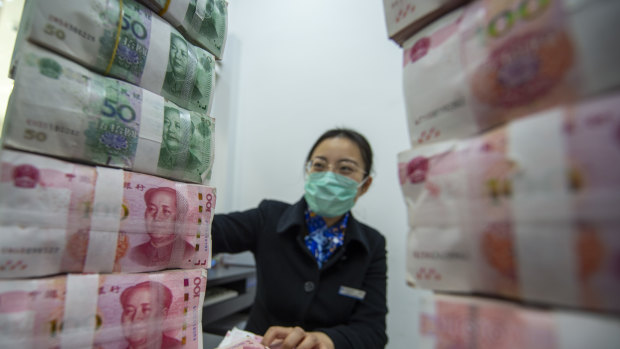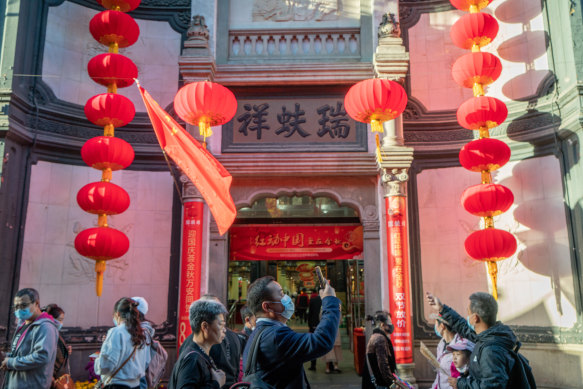This was published 4 years ago
Opinion
Does China know something the rest of the world doesn’t?
Stephen Bartholomeusz
Senior business columnistWhy did China announce a cut to its banks’ reserve requirements last week? What do they know that the rest of the world doesn’t?
The government announced a 50 basis point reduction in its reserve requirement ratio, effective from this Thursday, which should add about 1 trillion yuan ($210 billion) of liquidity to its banking system.

China’s move will add about 1 trillion yuan to its banking system.Credit: Getty
It will be the first cut to the ratio since it was reduced three times during the early phase of the pandemic more than a year ago, allowing China’s banks to lend more and at a lower rate.
What’s unclear is whether the change is directed primarily at the banks or at the broader economy.
Either way, while it’s too modest a change in monetary policy to signal fear, it does indicate concern. China’s economy is slowing as the rest of the world’s dramatic increase in consumption of its goods during the most intense period of the pandemic wanes, even as the authorities have resumed their attempt, frozen in 2020 as they responded to the pandemic, to deleverage an over-leveraged economy.
When its June quarter GDP numbers are published this week they are expected to show growth of about 8 per cent, well down on the 18.3 per cent growth in the March quarter.
That March quarter number, however, was inflated by the depressed base provided by the corresponding period of last year and the extraordinary spending binge that households in the developed world have been on amid the continuing effects of the pandemic.
The uncertainty as to whether the change to the reserve requirements is targeted at the banks or the broader economy is due to the coincidence of the emergence of a continuing spate of bad debts among China’s larger state-owned enterprises with the signs of a slowing economy.
Sporadic outbreaks of the coronavirus, including the nasty Delta strain – China’s major export hub, Guandong province, was hit by an outbreak last month – have added to the opacity of the authorities’ motivations.
The bad debts that have hit the big end of China’s property development sector hard may be impacting its banks where, after being urged to lend more last year to counter the effects of the pandemic, their willingness or ability to extend credit, particularly to small and medium-sized businesses, appears to have been reduced significantly this year.
For the rest of the world, an earlier and faster slowdown in China’s growth rate than expected provides an ominous warning of what might be to come.
The additional liquidity and capital unlocked by the change to the reserve requirements could reflect an awareness that the crackdown on leverage might be having some unintended consequences.
It might also be a recognition that the economy is slowing faster than the authorities anticipated.
Recent manufacturing and service industry indicators are pointing to a sharp slowdown in activity amid weaker domestic consumption, higher input costs, the recovery in most developed economies, the continuation of the US trade and financial sanctions and an expanding rift between China and the West.
Only weeks ago China’s authorities were so concerned about the soaring cost of industrial inputs on their industries’ profitability that they called in the senior executives in the metals industry to warn them of punishment for excessive speculation while also threatening traders in derivatives markets.
That’s had some limited effects (although the iron ore price remains elevated) but factory gate prices still rose nearly nine per cent last month.
That was down only marginally on May, when the surge in commodity prices was generating the fastest growth in prices in more than a decade, undermining the profitability of manufacturers and/or their competitiveness and generating inflationary pressures.
Apart from the spikes in commodity prices the economy, like economies elsewhere, has been hit by supply chain disruptions and the shortage of semi-conductors being experienced globally. That has particularly hurt China’s auto industry, a key sector of its domestic economy.
China has traditionally used the reserve requirements as one of its first lines of defence against an economic downturn – it dials them up and down far more frequently than occurs in most other major economies – but the current move looks more like fine-tuning and insurance at this point than large-scale stimulus.

China might be more worried about its economy than it appears.Credit: Bloomberg
Its economy is still expected to post growth of more than 8 per cent for the full calendar year thanks to the turbo-charged first quarter before sliding back to six per cent, or something a little lower, in 2022.
For the rest of the world, an earlier and faster slowdown in China’s growth rate than expected provides an ominous warning of what might be to come.
China was impacted earlier than the rest of the world by COVID-19 but also emerged from the worst of the economic impacts first.
The outbreaks of the virus this year and the emergence of the Delta strain are consistent with what is happening in the rest of the world, which has also been rebounding – later and at lower rates than China – from their economic nadirs a year ago.
The “V” in those recoveries may, if China’s experience is a guide, may be shallower and more volatile than currently anticipated even though most of the western economies injected far more stimulus into their economies than China.
Given that that stimulus was funded with debt – and most of those economies went into the pandemic with government balance sheets still over-burdened with the legacy of the 2008 financial crisis – a premature economic slowdown amid fresh outbreaks of the more virulent mutations of the virus could be quite threatening.
As it stands, China has taken the first step towards a more expansive monetary policy (albeit not yet more expansive fiscal policy) even as the central bankers in the other major economies are discussing when and how to start unwinding the monetary stimulus they flooded their economies with last year.
As China’s economy slows, there is also the prospect that the US, if the Biden administration can get past Congress, will embark on an unprecedented debt-funded investment in its economy that could be expected to underpin strong growth rates. A significant element of the Biden policies is also directed towards further decoupling of the US economy from China’s while urging US allies to follow suit.
That combination of diverging monetary and fiscal policies and, perhaps, an increasing de-linking of China’s economy from the West, would complicate China’s economic management and longer term ambitions given that its economy, despite the authorities’ efforts, remains export-dependent.
The Business Briefing newsletter delivers major stories, exclusive coverage and expert opinion. Sign up to get it every weekday morning.